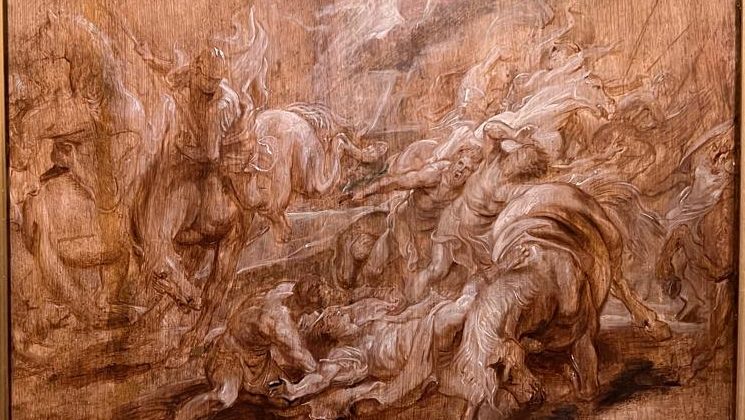When thinking about the Ashmolean, most students will nod and agree that Oxford’s most famous museum resides somewhere in the back of their memory. Most will boast of a few trips over the length of their degree. Some may have gone with their parents, or, as a rare experience, with their tutors (to the joy of my second-year English class). Some may tell you about how the lantern that Guy Fawkes held on the night of the Gunpowder Plot is there, others about Powhatan’s (the father of Pocahontas) mantle. But for me, the unsung heroes of the museum lie in the many galleries that the upper levels hold. In the Weldon Gallery, hosting the European Baroque art, you would find some of my favourite pieces, which make a trip to the museum at least a termly occasion. These include a collection of oil sketches completed by Sir Peter Paul Rubens and Anthony Van Dyk. They depict various scenes charged with the typical dynamism of the Baroque, yet presented in white and grey, with the warm brown tones of the panels they are painted on. The piece I want to focus on is Rubens’ The Conversion of St. Paul.
In the 16th and 17th centuries, Rubens and his assistant, Van Dyk, were working in the region commonly known as Flanders, in Belgium. In the 16th century, the region fell under Catholic Spanish rule, triggering a surge of an emotive, devotional art as churches and monasteries looked to fill their sanctuaries. Not only that, but Antwerp, located on the river Scheldt, became Europe’s hub for trade, importing masses of precious metals, textiles and spices. This in turn fuelled the artistic scene with the money that came in, as the urban elite looked for artistic compositions for their own homes. Rubens’ The Conversion of St Paul is not what would have hung in the halls of these great Flemish houses, but rather stands as a study for a larger painting. Indeed, the function of a drawing could shift from a capturing sketch to an independent piece, but many were used to prepare for a final composition, like the work we are examining here. The mediums for these sketches varied, but preparatory studies were mostly done using wet materials, such as inks and washes, which allowed for fluent strokes. This sketch depicts St. Paul’s Damascene conversion to Christianity from the Acts of the Apostles. Thrown from his horse by a blinding, heavenly light, Paul lies sprawled on the ground, with Christ at the centre of the celestial beacon. What is particularly interesting to me (I am no artist, so bear with) is the way Rubens incorporates light, even when using just two colours. Both illuminating and defining the careful edges of the figures, Rubens uses light as the dramatic and spiritual core of the composition. Light, here carefully presented in white, functions as a tangible manifestation of divine intervention, transforming what could be chaos into a spiritual awakening, providing us with captivating perceptions of depth and shape.
Most people would not note the sketches as they walked around the museum. When there are larger, brighter paintings on display, the muted tones of these cursory sketches may struggle to catch the eye. With our modern-day overexposure to art online, we can see hundreds of paintings any time, which can desensitise us to the effort that takes place behind each piece. Paintings hold within them an enormous number of decisions. This is where the crux of my fascination with Rubens’ sketch lies. The deeply personal panel allows us to follow the thoughts of the artist, giving insight into this tantalisingly meticulous process. We peer over his shoulder at the panel. We can compare this with the final piece (even though the Berlin painting was destroyed in 1945) and speculate over the motivations for change.
Why is art, and specifically this kind of preliminary work, still relevant today? In the advent of Artificial Intelligence (AI), where pictures can be created with minimal effort but seemingly unlimited potential, how do we define art? Because while many scoff at what is being generated today, the technology continues to evolve, with developers asserting that AI will foster greater creativity. Yet they assume that effort is not necessary in art. And while I don’t think that every artistic creation requires extensive labour, I do believe that intention, and choice, are essential. The innumerable, small choices made while developing a piece make just as much impact as the larger choices for the conception of art. Painters do not work through a straightforward process but, by constantly reworking ideas, go through their own personal evolution. AI, on the other hand, works linearly, not using effort but algorithm. Look at the innovations of The Conversion of St Paul; for Rubens, every figure had an impact and every figure was modified before his final painting. The Conversion of Saint Paul, and its other variations, exemplifies Rubens’ experimentation. There is a demonstration of craftmanship, of the humanity behind art, in sketch. I believe that art’s definition is something created by personal choices, ineluctable to human creation.
So personally, I wouldn’t mind having this oil sketch hanging in my home, and I really recommend a probably long-overdue trip to the Ashmolean.

